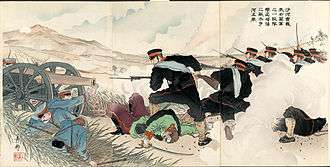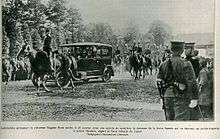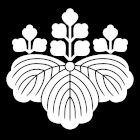Imperial Guard (Japan)
In Japan the Imperial Guard (御親兵, Goshinpei) is the name of two separate organizations dedicated to the protection of the Emperor of Japan and the Imperial Family, palaces and other imperial properties. The first was the Imperial guard divisions (近衛師団, Konoe Shidan), a quasi-independent branch of the Imperial Japanese Army being dissolved just after World War II. The second is the Imperial Guard Headquarters (皇宮警察本部, Kōgū-Keisatsu Honbu), a civilian law enforcement organization formed as part of the National Police Agency.
Imperial Guard of the Imperial Japanese Army
| Imperial Guard | |
|---|---|
| 近衛師団 | |
 The ensign of the Imperial Japanese Army | |
| Active | 1867–1945 |
| Disbanded | 1945 |
| Country | |
| Allegiance | |
| Type | Army |
| Role | Infantry Cavalry Artillery |
| Size | 3 Divisions 10 Regiments |
| Garrison/HQ | Tokyo |
| Engagements | Satsuma Rebellion Sino-Japanese War Russo-Japanese War World War I World War II |
| Commanders | |
| Notable commanders | Yamagata Aritomo, Ōyama Iwao, Kotohito Kan'in, Hajime Sugiyama, Hideki Tojo, Yasuji Okamura, Shunroku Hata, Tadamichi Kuribayashi, Tomoyuki Yamashita, Masaharu Homma |


The Imperial Guard of the Imperial Japanese Army was formed in 1867. It became the foundation of the Imperial Japanese Army after the Emperor Meiji assumed all the powers of state during the Meiji Restoration. The Imperial Guard, which consisted of 12,000 men organized and trained along French Military lines, first saw action in the Satsuma Rebellion. It was organized into the 1st Guards Infantry Brigade which had the 1st and 2nd Regiments. The 3rd and 4th Regiments belonged to the 2nd Guards infantry Brigade.
By 1885 the Imperial Japanese Army consisted of seven divisions, one of which was the Imperial Guard. A division consisted of four regiments containing two battalions each. The Imperial Guard division was based in Tokyo and recruited nationally.
After the Russo-Japanese War in 1905, a second Guard Brigade was formed from indigenous Formosans. In 1920 the Guards Cavalry Regiment, Guards Field Artillery Regiment, Guards Engineer Battalion, Guards Transport Battalion, plus other Guards service units were added.
From 1937 to 1939 the Guards Engineer Battalion was expanded into a regiment as was the Guards Transport Battalion.
Pacific War
In September 1939, the division was split into the 1st and 2nd Guards Brigades.
The 1st Guards Brigade, which contained the 1st and 2nd Guards Infantry Regiments, the cavalry regiment, and half of the support units, was transferred to South China. Here it became known as the Mixed Guards Brigade. In October 1940, it joined other Japanese units occupying French Indo-China. In April 1941 the Mixed Guards Brigade returned to Tokyo but it did not rejoin the Imperial Guards Division.
The 2nd Guards Brigade, which contained 3rd and 4th Guards Regiments, also went to China. In 1940, it went to Shanghai before being posted to Hainan Island. In June 1941, the 5th Guards Infantry Regiment joined the 2nd Guards Brigade becoming the Imperial Guard Division again. It later saw action in the Battles of Malaya and Singapore with Tomoyuki Yamashita's 25th Army.
In May 1943, all designated Imperial Guard units were renamed again. The Mixed Guards Brigade in Tokyo became the 1st Guards Division (which now consisted of the 1st, 2nd, 6th Guard Regiments) and the Imperial Guard Division became the 2nd Guards Division. The 3rd Guards Division, which never left Japan, was formed in 1944. It consisted of the 8th, 9th and 10th Guards Regiments. Sources do not agree if there ever was a 7th Guard Regiment.
All military Imperial Guard Divisions were dissolved at the end of World War II.
War crimes
In Malaya and Singapore, the Guard Division was involved in several notorious Japanese war crimes such as the Parit Sulong Massacre and the Sook Ching massacre. Lt Gen. Takuma Nishimura, who was sentenced to life imprisonment by a British military court in relation to the Sook Ching killings, was later convicted of war crimes by an Australian Military Court in relation to the Parit Sulong massacre. He was executed by hanging on June 11, 1951.[1]
Uniform

Until 1939, the Cavalry of the Imperial Guard wore a French style parade uniform consisting of a dark-blue tunic with red Brandenburg braiding, a red kepi and red breeches. The red kepi had a white plume with a red base. Prior to the general adoption of khaki by the Japanese Army during the Russo-Japanese War (1904-1905), an all white linen uniform had been worn in hot weather.
The Infantry of the Imperial Guard wore a dark blue uniform with white leggings for both parade and service wear until 1905. It was distinguished from that of the line infantry by a red band and piping on the peaked service cap (instead of yellow). Officers wore a dark blue tunic with 5 rows of black mohair froggings and dark blue breeches with a red stripe down each seam.
Following the adoption of a khaki service dress, the Guard Infantry wore this on all occasions, although officers retained the blue and red uniform for certain ceremonial occasions when not parading with troops.
In the field, the army's standard khaki uniform was worn by all Imperial Guard units from 1905 to 1945. Guard units were distinguished by a wreathed star in bronze worn on the headgear, in contrast to the plain five pointed star worn by other units.
Imperial Guard of the National Police Agency
| Imperial Guard Headquarters Kōgū-Keisatsu Honbu 皇宮警察本部 | |
|---|---|
 Seal of the Imperial Guard Headquarters | |
| Abbreviation | IGH |
| Agency overview | |
| Formed | January 1, 1947 (as the Imperial Guard Bureau of the TMPD) |
| Preceding agency |
|
| Employees | 936 people (896 of them are palace guards)[2] |
| Annual budget | 8,366,559 thousand yen per year (FY 2018)[3] |
| Jurisdictional structure | |
| Operations jurisdiction | Japan |
| Specialist jurisdiction |
|
| Operational structure | |
| Overviewed by | National Police Agency |
| Headquarters | Tokyo |
| Agency executives |
|
| Units | List
|

After the disbandment of the Imperial guard divisions, their missions were merged into the Imperial Police (皇宮警察, Kōgū-Keisatsu), a civilian law enforcement branch of the Ministry of the Imperial Household. In 1947, it was reorganized into the Imperial Guard Bureau (皇宮警察部, Kōgū-Keisatsu-bu) of the Tokyo Metropolitan Police Department, and then transferred to the National Rural Police (国家地方警察, Kokka Chihō Keisatsu Honbu). After several renaming, it became the Imperial Guard Headquarters (皇宮警察本部, Kōgū-Keisatsu Honbu) in 1949. With the total reconstruction of the Japanese police systems in 1954, it became a part of the National Police Agency.
At present, it consists of over 900 security police personnel who provide personal security for the Emperor, Crown Prince and other members of the Imperial Family, as well as protection of imperial properties, including the Tokyo Imperial Palace, Kyoto Imperial Palace, Katsura Imperial Villa, Shugakuin Imperial Villa (both in Kyoto), Shosoin Imperial Repository in Nara and the imperial villas as Hayama, Kanagawa and Nasu, Tochigi.[4]
The Imperial Guard also maintains a 14 horse mounted police unit for use by guards of honour at state ceremonies. In addition to their security duties, the Imperial Guard is also responsible for fire-fighting within the grounds of the Palace, and maintains fire engines and trained staff of this purpose.
The NPA Imperial Guards wear a dark blue or a blue-grey police uniform with white gloves while on duty with peaked caps for public duties activities. They also wear white pistol belts, lanyards, helmets, boot laces or leggings. They carry police rank insignia in their shoulder boards.
Gallery
 An Imperial Guard Music Band marching through Tokyo in the 1950s.
An Imperial Guard Music Band marching through Tokyo in the 1950s. Mounted Imperial Guard police officers in the 1950s.
Mounted Imperial Guard police officers in the 1950s.- Mounted Imperial Guards during a presentation of credentials ceremony in Tokyo.
 An Imperial Guard sentry at the Seimon Ishibashi bridge outside the Imperial Palace.
An Imperial Guard sentry at the Seimon Ishibashi bridge outside the Imperial Palace. Modern Imperial Guards at the Imperial Palace in Tokyo
Modern Imperial Guards at the Imperial Palace in Tokyo- Imperial Guards in a patrol car within the gardens of the Imperial Palace in Tokyo
 Special Security Unit (特別警備隊, Tokubetsu keibi tai) of the Imperial Guard Headquarters
Special Security Unit (特別警備隊, Tokubetsu keibi tai) of the Imperial Guard Headquarters
See also
- Bodyguard
- Imperial Guard
- Manchukuo Imperial Guards
- Imperial Japanese Army
References
- 7th Battalion The Cameronians Multiple Sclerosis Research Initiative
- 警察庁の定員に関する規則(昭和44年6月5日国家公安委員会規則第4号), translation: Regulations on Capacity of National Police Agency (National Public Safety Committee Regulation No. 4, June 5, Showa 44) "(Final revision: National Security Public Safety Committee Regulation No. 8, Heisei 30, 1990)
- 単位:千円。2018年度(平成30年度)当初予算 - 一般会計(内閣 「平成30年度予算書関連」 財務省)。
- https://www.npa.go.jp/kougu/outline/index.html?goto=section02
- Madej, W. Victor, Japanese Armed Forces Order of Battle, 1937-1945 [2 vols] Allentown, PA: 1981
External Links




- Official NPA IG page
